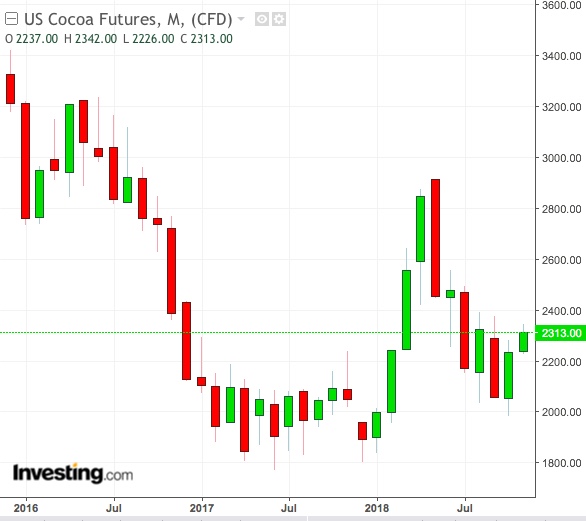After steep losses in 2016 and 2017 and amid lingering worries of oversupply, not many had wagered on a super run for cocoa this year. But with only eight weeks left and festivities promising copious consumption of chocolates and baked treats, cocoa could well finish as 2018’s 'Commodities King.'

Futures of the ingredient critical to confections and beverages are up 22 percent year-to-date on the New York Mercantile Exchange, eclipsing the commodity's 11 percent loss for last year and even more stunning drop of 33 percent in 2016.
For now, the only commodity that appears to have a real chance of dethroning cocoa is natural gas, with its 19 percent gain that could tick higher with the onset of colder weather and heating demand across most of the United States.
Overbought, But Still Rated 'Strong Buy'
Many commodity technicians on Investing.com are recommending a “Strong Buy” in cocoa, despite price charts suggesting an overbought market after rallies in seven out of the past 10 months. That’s on top of physical demand already in place for the commodity, driven by year-end festivities, where ready-to-eat chocolates and cocoa powder for baking are a must.
“Cocoa has entered its strong demand season, as Christmas is right around the bend,” said Mike Seery, chartist at Seery Futures in Plainfield, Illinois, who noted that the market’s “chart structure has also improved tremendously over the last several weeks.”
In a note issued on Monday, Seery said NYMEX cocoa, which hovers above $2,310 a tonne, could take out its August 27th high of $2,397, which he described as “major resistance.” He added:
“If that is broken, I think we can go substantially higher as the bullish trend is getting stronger on a weekly basis. Continue to play this to the upside as I will be looking at adding more contracts possibly later this week once the risk/reward improves again.”
What led to this year’s runaway demand for cocoa, after the dismal performance of 2016 and 2017?
Global Economy The Driver
Some point to the turnaround in the global economy—US growth in particular—and how that’s boosted cocoa grinds of late. Grinding creates important primary products from cocoa, such as the cocoa powder used for baking such items as cakes and biscuits, and the cocoa butter that goes into giving chocolates and ice cream their smooth, creamy taste.
North American cocoa grinds turned out about 2 percent less products in the first half of 2018 versus the same period a year ago, amid a 6 percent improvement in European grinds and a 10 percent jump in Asian output. But in the third quarter, the North American figures jumped 2.5 percent, adding to the 2.7 percent rise in Europe and 3.7 percent climb in Asia.
“Demand is very strong, with cocoa bean processing margins very strong,” said Shawn Hackett of Hackett Financial Advisors, an agricultural markets consultancy in Boca Raton, Florida.
Adverse Weather, Under-Invested Crop Concerns Too
In an outlook published Monday, Hackett said smart money has been bullish on cocoa since a buy was signaled by early October lows. He added:
“Some modest selling has occurred … but make no mistake, smart money remains in a bullish position arguing for higher prices.”
Fundamentally, Hackett cited adverse weather in the world’s top cocoa growing region of West Africa, along with a buyer default crisis there that had brought long-term prospects for investing in the crop to a standstill a few years ago. Said Hackett:
“Lack of credit and bankrupt producers leave an aging cocoa tree population vulnerable to a long-term production stagnation against steady increases in global demand. We think the cocoa market is beginning to worry about this, and has bid up the market despite widespread bearishness by the analyst community due to current large crop expectations.”
